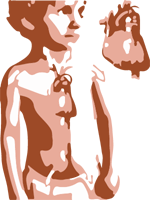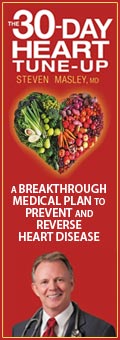Coarctation of the aorta
Coarctation of the aorta in adults is located in the aortic arch just below the left subclavian and near the ligamentum arteriosum. Bicuspid aortic valve occurs in 25% of cases. Blood pressure is increased in the aorta and proximal to the narrowing of the branches, while in the distal parts is reduced. Collateral circulation between the high and low pressure develops in aortic segments through intercostal arteries and branches of subclavian.
The clinical picture of coarctation of the aorta
Symptoms and signs of coarctation of the aorta
Symptoms may not appear until hypertension does not lead to left ventricular deterioration or cerebral hemorrhage. Strong arterial pulsations are seen in the neck. There is hypertension in hands, but the blood pressure is normal or decreased in the legs. These differences increase with fatigue, which is used for diagnostic purposes in doubtful cases. Pulsations in arteria femoralis are absent or weak and extended in comparison with pulse of arteria brachialis. Late systolic murmur that can be heard at the base, sometimes is better heard at the back, especially through the processus spinosus.
Radiographic findings of coarctation of the aorta
Radiographic findings shows the ribs that arise due to increased intercostal arteries, dilatation of the left subclavian artery and poststenotic dilatation and enlargement of the left ventricle.
ECG showed signs of left ventricular hypertrophy, and in moderate cases can be normal.
Treatment for coarctation of the aorta
Coarctation of the aorta is counted as a far more serious surgery than ligature of the patent ductus arteriosus. The surgical mortality rate is somewhere between 1-3%.
It is recommended that all patients with coarctation of the aorta have to operate until 20 year of life. In the years between 20 and 35 surgery is recommended if the patient feels unwell. Mortality increased significantly in patients over 50 years of age, and surgery is very risky at this age.
Prognosis for coarctation of the aorta
The majority of patients with coarctation of the aorta dies before the age of 40 and of complications such as hypertension, aortic rupture, bacterial endocarditis, cerebral hemorrhage (congenital aneurysm).
However, 25% of patients have normal prognosis and dies of causes not related to coarctation of the aorta.
You may also like:
- The Blalock Taussig shunt
The Blalock Taussig shunt is a temporary surgical operation that is performed on newborn babies. The Blalock Taussig shunt is done when the heart is not delivering enough blood enriched with oxygen to the rest of the body.
- Glenn shunt procedure and bidirectional Glenn shunt surgery
Glenn shunt is a temporary treatment that is applied on children (preceding the Fontan procedure) to improve blood flow to the lungs.
- Fontan procedure
The Fontan procedure is an open heart surgical procedure used in children with a defect in the structure of the heart and great vessels which are present at birth.



